Globe valves are operated with a handwheel and modulate water flow. But they also cause higher pressure loss.
Picking the right valve is important, as different types have different features and uses. Some of them only have two states: open or closed. Others allow fluid flow and pressure to be modulated. Distinct valves also cause different amounts of pressure loss. Depending on the situation, specific features are needed.
One of the most common types of valves is the globe valve. In this article, we explain how globe valves work, including their advantages and disadvantages. Then, we look at the different shapes of globe valves and compare them to other types of devices, like gate valves and ball valves.
QRFS stocks a wide range of valves, including globe valves. Shop T-shaped globed valves and angle valves now.
What is a globe valve, and how does it work?
To decide if a globe valve is right for your application, consider its three core features. First, they are lateral movement valves, which means they open or close based on the up-and-down movement of a stem. Second, they allow, stop, or throttle fluid flow. Some valves have only open and closed states, but globe valves can throttle flow without totally stopping it. Third, they cause significant head losses compared to other valves, a tradeoff for the throttling services.
How globe valves work
From the outside, globe valves have three parts, a handwheel, a bonnet, and a body. The bonnet houses a stem, and when the handwheel is turned, the stem screws up and down in the bonnet. The end of the stem has a small component called a disk or plug, which can be metallic or non-metallic and may come in different shapes, depending on the need.
The globe-shaped body for which the valve is named houses a seat. The seat is a metal frame that divides the body into two chambers and has a hole to allow fluid to pass. When the valve is open, fluid flows up through the opening in the seat. To close it, the stem is screwed down until the disk blocks the seat’s opening.
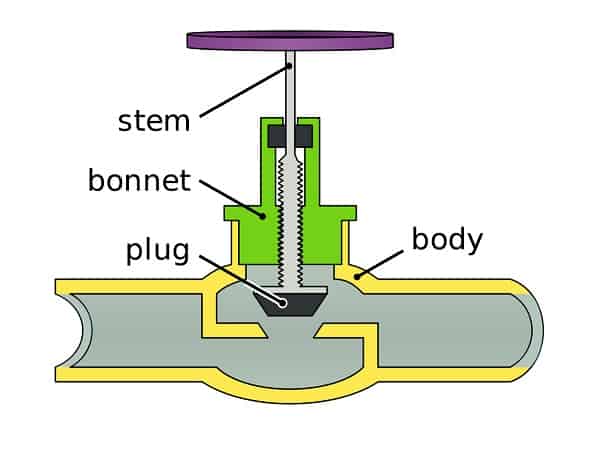
One of the main advantages of globe valves is their ability to throttle or modulate flow. Besides being closed or open, they can also be partially open. This allows you to adjust flow without totally stopping it.
The main disadvantage of globe valves is the comparatively significant head loss they create. Head loss, also called pressure loss, refers to the amount of resistance a liquid encounters as it flows through pipes. The more resistance, the more pressure that is lost. Gravity, friction (of the fluid against the walls of the pipe), and turbulence all cause this loss. Valves and fittings cause pressure loss mainly through turbulence.
Globe valves force fluid to change directions as it passes through, creating loss and turbulence. The exact amount of loss depends on factors like fluid velocity and friction factor. However, it’s still possible to review the pressure losses from different valves using a metric called the L/D coefficient.
A valve’s L/D coefficient lets us compare it to a straight section of pipe with the same friction factor. L and D stand for length and diameter, respectively. A valve with L/D=5 creates the same friction loss (all else being equal) as a section of pipe with a length-to-diameter ratio of 5. The larger L/D is for a component, the higher the head loss it creates.
A standard globe valve has an L/D=340, compared to an L/D=30 for a 90-degree pipe elbow.
Globe valve shapes
Globe valves come in three shapes—t-pattern/z-pattern, y-pattern, and angle pattern. Each form stops or throttles fluid flow in the same way, but the path of flow—and thus the head loss—differs.
Most globe valves are t-shaped globe or z-shaped. They are called “t-pattern” for the profile of the valve—the inlet and outlet of these valves are in a straight line. “Z-shaped” is arguably more descriptive, however, because it refers to the path of the water as it flows through the valve rather than the device’s external shape. In the standard z-shaped globe valve, the water changes direction twice in a pattern that resembles the letter Z. As mentioned, standard Z-shaped valves cause the most significant head loss, with an L/D=340.
Y-pattern globe valves are modifications of z-pattern valves. The inlet and outlet are still in a straight line, but the bonnet and stem are placed at an angle to the body (as opposed to perpendicular), forming a y-shaped profile. This provides a straighter path for the water than the z-shape, reducing head loss. For y-pattern globe valves, L/D=55.
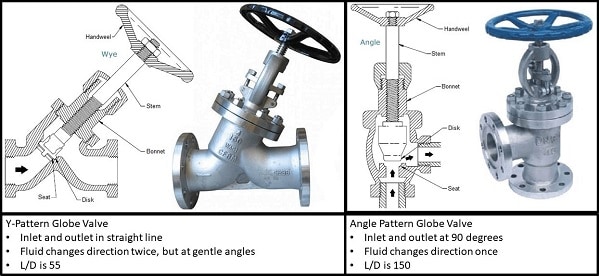
The inlet and outlet of angle valves are oriented at 90 degrees from one another, and these devices serve both as elbows and valves. Because they only make fluid change direction once, they create less head loss than z-shaped valves, with L/D=150.
When to use globe valves
Globe valves are ideal whenever you need to modulate flow, but you don’t have to worry about the amount of pressure loss. Some applications include:
- Cooling water systems
- Fuel oil systems
- Feedwater and chemical feed systems
- Turbine lubricating oil systems
- Drain and trim applications in fire sprinkler or other water-based fire protection systems
Globe valves aren’t the best choice for control valve applications in fire sprinkler systems, where pressure is at a premium. Instead, butterfly valves are commonly used.
Globe valve vs. gate valve
There are several alternatives to the globe valve, and understanding the different options can help you pick the right valve for the job. Two major alternatives to the globe valve are the gate valve and the ball valve. First, let’s consider the differences between globe and gate valves.
Gate valves, like globe valves, are linear-motion valves. They are opened and closed by turning a handwheel that screws a stem in and out of the bonnet. When a gate valve is closed, an obstruction is pushed down by the stem perpendicular to the path of the fluid.
Unlike globe valves, gate valves don’t require fluid to change directions—the flow path is straight. As such, gate valves cause very little head loss (L/D=8). However, they do not throttle as well as globe valves—fluid flow rate in a gate valve is not proportional to how open the valve is at any moment.
Globe valve vs. ball valve
Unlike globe valves and gate valves, ball valves are rotary-motion valves. This means that ball valves open and close when the obstacle rotates rather than opening and closing with the lateral movement of an obstruction. Specifically, a ball-shaped component with a hole through it spins in its housing, either stopping the fluid or letting it pass.
Instead of turning a handwheel, a ball valve is typically opened or closed with a wrench handle. Only a quarter-turn (90 degrees) is needed to open or close it—much faster than turning a handwheel multiple times. Quick closing can actually be a problem because of water hammer. When fluid flowing through a pipe is suddenly stopped, its momentum has nowhere to go because water is non-compressible. Water hammer occurs when a pressure wave propagates back through the pipe, potentially causing damage.
Since ball valves don’t force water to change direction, they create very little head loss (L/D=3). As with gate valves, this low pressure loss comes with the tradeoff of little throttling capability. Ball valves are either open or closed, with little in-between.
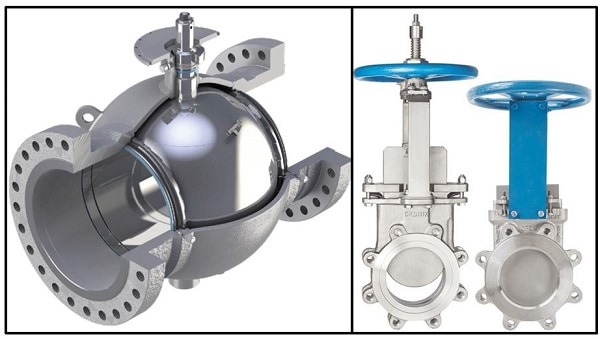
Globe valves adjust flow, but be careful of the pressure application
When building a piping system, it’s important to choose the right components for the job, which is especially true with valves. Because globe valves force water to change directions even when fully open, they create comparatively large pressure losses. One of the core advantages of globe valves, however, is their ability to modulate water flow. They can be open, partially open, or closed.
Gate valves and ball valves, two alternatives to globe valves, cause minimal pressure losses. However, they don’t provide throttling services like globe valves. For applications where pressure is at a premium, gate or ball valves are better choices than globe valves.
Shop our inventory of standard (z-pattern) globe valves and angle valves. For other options, shop our full selection of valves, including ball valves. If you don’t see the item you need, contact us, and our customer service team will help you out.
This blog was originally posted at blog.qrfs.com. If this article helped you, check us out at Facebook.com/QuickResponseFireSupply or on Twitter @QuickResponseFS.


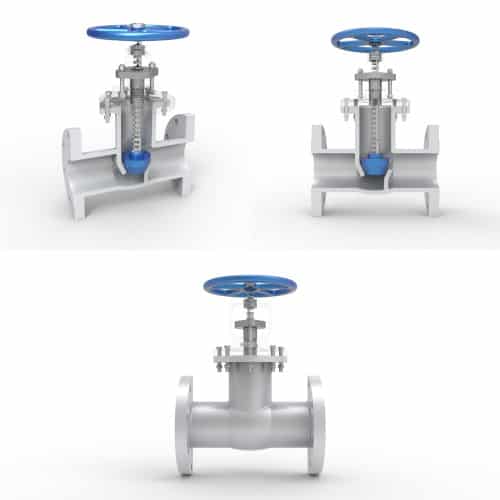
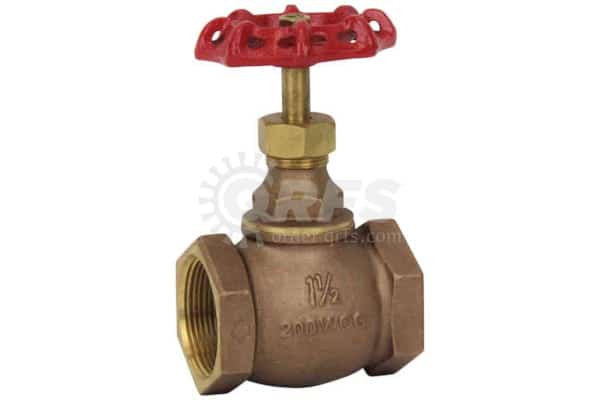

Hello, an experienced plumber by the name of my uncle is now working on a project to fix an ancient water main. To ensure that the water flow can be successfully managed, he is searching for a Replaceable Bonnet Gate Valve to replace a broken one. Knowing that angle valves are both elbows and valves, with the inlet and outlet positioned at 90 degrees from one another, will be helpful to him.